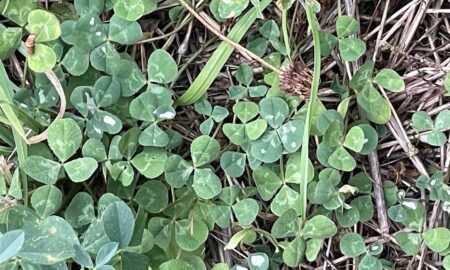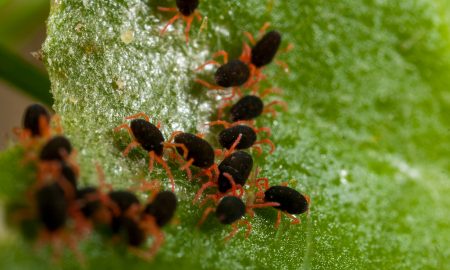First Published: August 31st 2020
August typically signals the beginning of the native budworm season in south-eastern Australia.
Here we provide ongoing updates about native budworm in spring 2020.
Scroll to:
A recap – who is the native budworm?
Native budworm moth monitoring
A recap – who is the native budworm?
The native budworm is the common name for Helicoverpa punctigera, a native Australian moth. It is sometimes still referred to as ‘Heliothis’ because the scientific name was previously Heliothis punctigera.
The native budworm is thought to breed on native flowering plants in the arid, inland regions of Australia during winter.
In late winter and spring, these moths fly hundreds if not thousands of kilometres and typically arrive in the south-eastern cropping regions from the north or north-west.
The moths lay eggs in several agricultural crops, including pulses and canola and the ensuing larvae (immature lifestage) feed on developing pods and seeds.
Native budworm moth monitoring
Luckily this is one species where growers and agronomists can be forewarned about their arrival and activity in crops.
The arrival of native budworm moth flights into agricultural regions can be monitored with pheromone traps. These traps use a female sex scent lure that attracts male moths of the native budworm.
The timing (and size) of moth catches provide an indication of when egg-laying commences, and when crop monitoring should start.
From early August, with the help of agronomists and growers, pheromone traps have been set up in pulses and canola in locations in the Victorian Wimmera and Mallee, and the Murray and Central West regions of NSW.
Moth traps are most useful in showing peaks of flight activity across time in different regions from which we can predict when damaging grub stages (>3rd instar, 8 – 13 mm) will be present but are less useful in predicting relative activity across regions. For example, past experience has shown that despite higher moth catches in the Victorian Mallee than the NSW Riverina, similarly damaging grub numbers can be found across the regions.
Moth activity updates
Update on September 16th
Over the past 6 weeks our trapping network has detected very few moths. Weekly catches have generally been under 10 moths and even 0 in some cases.
The activity has been unusually low.
To put this into perspective, traps located in the northern Mallee (Ouyen and Swan Hill) usually have the largest catches and it’s common to count >100 moths per week at times during September.
At first, we thought moth activity could just be low so far this year, but we can’t eliminate the possibility that it also could be that our batch of lures in use are less sensitive than usual.
This is supported by a report from the Mallee where another native budworm pheromone bucket trap near Swan Hill (separate from our network) has been picking up around 40 moths per week, and by mid-September, > 100 moths. The report indicated that further bucket traps set up near Wycheproof and Tocumwal are nearing similarly large catches by mid-September.
To ensure the traps are working as effectively as possible, we will endeavour to change to a new set of lures over the next week or so.
Update on October 14th
Our moth trap network detected an increase in moth activity in south-eastern Australia over the past month.
In our September update we were unsure as to why moth catches had been low relative to previous years during August and the first half of September. We even suspected that our lures weren’t strong enough, so we had them replaced with a new batch just in case.
Interestingly, in the week prior to changing the lures, some of the traps started to record higher numbers. For example, the trap in Parkes, Central West NSW caught 96 moths over 10 days by the 22nd of September. Prior to this, weekly counts did not surpass 6 moths in this trap.
The first week of October has seen some of the larger catches (115 – 300 moths per trap) in North Central-Southern Wimmera (Marnoo, Rupanyup and Laharum). Another couple of traps were set-up in the Corangamite region on October 1st, with 220 and 200 moths caught over 10 days in Skipton and Lismore respectively.
Larvae activity updates
Update on September 16th
Between September 10 – 16th, we received first reports of larvae activity. West of Ouyen in the Victorian Mallee, six larvae were caught in 60 sweeps of lentil crop. Larvae were also found in lentils near Euston in Lower Western NSW. Near Hillston in the NSW Riverina, eggs were spotted in a field pea crop.
Update on October 14th
Feedback from advisers with respect to larvae number have been mixed. Some have observed that numbers of native budworm larvae are somewhat lower than usual, while other paddocks are supporting numbers similar to previous years and have required spraying at a similar time.
Monitoring for larvae
Remember moth counts don’t always necessarily reflect larvae severity. The best indicator of larvae population size in crops is to monitor with a sweep net or a beat sheet.
Monitor pulse and canola crops regularly using sweep nets; it is important to sample representative parts of the entire paddock prior before making a control decision.
Taking multiples of 10 sweeps within at least five locations in a paddock is recommended.
Monitoring crops should begin from early podding. As long as pods are green in pulses and other legumes, keep your sweep net at hand – we strongly recommend that monitoring of pulse and canola crops continue until they fully mature.
For more information including threshold calculation details, visit the native budworm PestNote.
Acknowledgements
Thanks to the following for setting up and monitoring a native budworm trap:
Andrew Rice (Aspire Agri), Jim Cronin and Max Ridley (Nutrien Ag), Adam Dellwo (Elders), Brad Bennett (Agrivision), Shayn Healey (Crop-Rite), Damian Jones (Irrigated Cropping Council), George Hepburn (Tyler’s Rural), Rob Fox (Fox and Miles), Bill Gardner, David White (Delta Ag), Ben Cameron.
Thanks to the following for providing field observations: Aaron Hutchison, Brad Bennett (Agrivision), Patrick Conlan (Dodgshun Medlin), Shayn Healey (Crop-Rite), Bruce Larcombe (Larcombe Agronomy).
Cover image: Photo by Andrew Weeks, Cesar Australia





